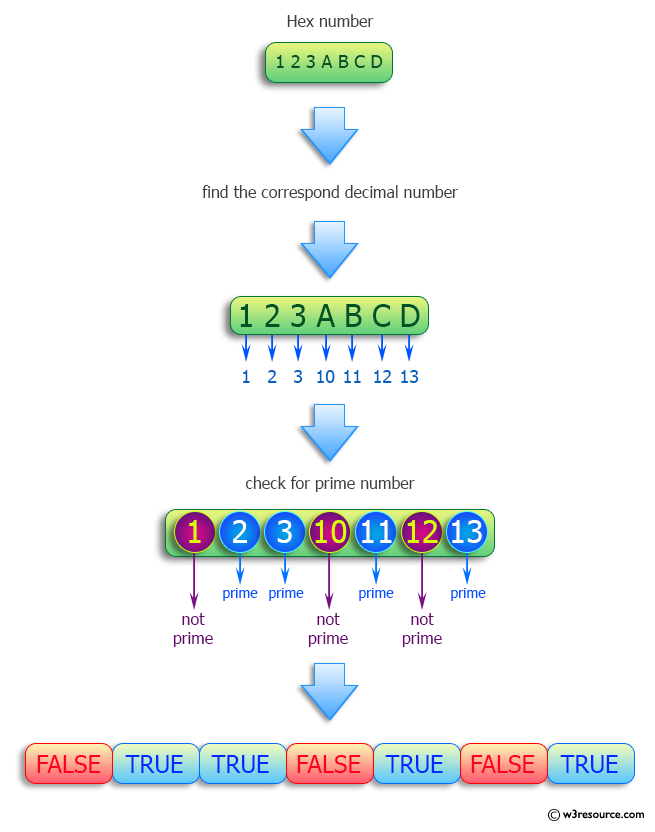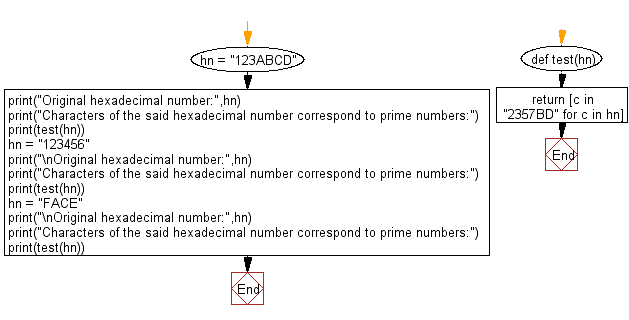Python: Determine which characters of a hexadecimal number correspond to prime numbers
Python Programming Puzzles: Exercise-44 with Solution
From Wikipedia:
The hexadecimal numeral system, often shortened to "hex", is a numeral system made up of 16 symbols (base 16). The standard numeral system is called decimal (base 10) and uses ten symbols: 0,1,2,3,4,5,6,7,8,9. Hexadecimal uses the decimal numbers and six extra symbols. There are no numerical symbols that represent values greater than nine, so letters taken from the English alphabet are used, specifically A, B, C, D, E and F. Hexadecimal A = decimal 10, and hexadecimal F = decimal 15.
A prime number (or a prime) is a natural number greater than 1 that is not a product of two smaller natural numbers. A natural number greater than 1 that is not prime is called a composite number. For example, 5 is prime because the only ways of writing it as a product, 1 × 5 or 5 × 1, involve 5 itself. However, 4 is composite because it is a product (2 × 2) in which both numbers are smaller than 4. Primes are central in number theory because of the fundamental theorem of arithmetic: every natural number greater than 1 is either a prime itself or can be factorized as a product of primes that is unique up to their order.
Write a Python program to find which characters of a hexadecimal number correspond to prime numbers.
Input: 123ABCD Output: [False, True, True, False, True, False, True] Input: 123456 Output: [False, True, True, False, True, False] Input: FACE Output: [False, False, False, False]
Pictorial Presentation:

Sample Solution:
Python Code:
#License: https://bit.ly/3oLErEI
def test(hn):
return [c in "2357BD" for c in hn]
hn = "123ABCD"
print("Original hexadecimal number:",hn)
print("Characters of the said hexadecimal number correspond to prime numbers:")
print(test(hn))
hn = "123456"
print("\nOriginal hexadecimal number:",hn)
print("Characters of the said hexadecimal number correspond to prime numbers:")
print(test(hn))
hn = "FACE"
print("\nOriginal hexadecimal number:",hn)
print("Characters of the said hexadecimal number correspond to prime numbers:")
print(test(hn))
Sample Output:
Original hexadecimal number: 123ABCD Characters of the said hexadecimal number correspond to prime numbers: [False, True, True, False, True, False, True] Original hexadecimal number: 123456 Characters of the said hexadecimal number correspond to prime numbers: [False, True, True, False, True, False] Original hexadecimal number: FACE Characters of the said hexadecimal number correspond to prime numbers: [False, False, False, False]
Flowchart:

Visualize Python code execution:
The following tool visualize what the computer is doing step-by-step as it executes the said program:
Python Code Editor :
Have another way to solve this solution? Contribute your code (and comments) through Disqus.
Previous: Find all words in a given string with n consonants.
Next: Find all even palindromes up to n.
What is the difficulty level of this exercise?
Test your Programming skills with w3resource's quiz.
Python: Tips of the Day
Find current directory and file's directory:
To get the full path to the directory a Python file is contained in, write this in that file:
import os dir_path = os.path.dirname(os.path.realpath(__file__))
(Note that the incantation above won't work if you've already used os.chdir() to change your current working directory, since the value of the __file__ constant is relative to the current working directory and is not changed by an os.chdir() call.)
To get the current working directory use
import os cwd = os.getcwd()
Documentation references for the modules, constants and functions used above:
- The os and os.path modules.
- The __file__ constant
- os.path.realpath(path) (returns "the canonical path of the specified filename, eliminating any symbolic links encountered in the path")
- os.path.dirname(path) (returns "the directory name of pathname path")
- os.getcwd() (returns "a string representing the current working directory")
- os.chdir(path) ("change the current working directory to path")
Ref: https://bit.ly/3fy0R6m
- New Content published on w3resource:
- HTML-CSS Practical: Exercises, Practice, Solution
- Java Regular Expression: Exercises, Practice, Solution
- Scala Programming Exercises, Practice, Solution
- Python Itertools exercises
- Python Numpy exercises
- Python GeoPy Package exercises
- Python Pandas exercises
- Python nltk exercises
- Python BeautifulSoup exercises
- Form Template
- Composer - PHP Package Manager
- PHPUnit - PHP Testing
- Laravel - PHP Framework
- Angular - JavaScript Framework
- Vue - JavaScript Framework
- Jest - JavaScript Testing Framework
